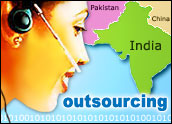
The most common and least understood marketing barrier facing outsourcing service providers is the absence of a strong brand. Most brands associated with IT and IT-enabled services (ITeS) companies are chosen on the basis of criteria relevant to where outsourcing firms are based, rather than where they intend to do business.
In the outsourcing industry, branding challenges are most acute for companies based outside of their target market — that is, based in locations with competitive cost advantages. Companies in these locations commonly face branding challenges due to incumbent brand selection and deployment practices.
Most offshore call centers, BPO (business process outsourcing) firms and software service companies are located in economies where major purchasing decisions havetraditionally been made on the basis of longstanding personal connections — rather than on the qualifications of a seller — and where buyers face fewer competitive choices than in the U.S.
In other words, most offshore outsourcing companies choose brands as if they were in a sellers’ market. It was a sellers’ market during the first five years (2000 to 2004) of the Indian call center boom and from 1995 to 2000 in the market for software services from India.
Buyer’s Market
Now, outsourcing is a buyer’s market, thanks to increased competitionfrom emerging destinations and the commodification of numerous types ofoutsourcing services: remote computer system administrationand ISP (Internet service provider) support services; collections and accounts receivable outsourcing; travel agency services; simple inbound call centerservices; medical claims billing; transcription; recruiting and otherhuman resources management activities.
A buyer’s market is facilitated by clients moving away from strategicsourcing with a single prime vendor and toward more sophisticatedvendor management practices with large numbers of specializedoutsourcing contracts designed for cost competitiveness and adherenceto performance metrics. Outsourcing version 1.0 is being replaced byoutsourcing 2.0.
In outsourcing 2.0, clients are no longer combing the globe seekingcompetitive service agreements from providers that lack marketing andbranding savvy. Now, outsourcing firms are attracting buyers through acombination of quality, value and brand image. Instead of clientsbeing happy to go from US$82 per production hour for onshore technicalsupport services to $18 offshore at a location with poor clientrelations skills, clients now seek to go from $18 offshore to $15offshore — and expect to receive service and reliability improvements.
Within client communities, brands are increasingly serving as adistinguishing mechanism for associating positive qualities to offshorefirms for which scant additional information may be available — at leastduring the initial stages of a procurement cycle. In the morecompetitive world of outsourcing 2.0, brand management has become astrategic imperative.
In the world of outsourcing 2.0, poor brand choices become marketinghandicaps. A good, persuasive brand can provide competitiveadvantages, especially in a buyer’s market. A brand can and shouldencourage buyers to make positive associations with a vendor.
In its broadest sense, the definition of “brand” can extend beyond thename of a company or service or product line to include brandsexpressed as graphic logos, slogans and color schemes. Here we focuson brands as names of companies and product or service lines.
The Ten Commandments of Branding
Failure to follow any one of the following 10 rules makes it difficultto market a company successfully. Any company that violates one ofthese rules needs to spend more money on sales and marketing tocompensate for poor branding choices.
- Focus on Target Markets
The first commandment of branding is that a brand has to work well in acompany’s target markets. This rule is often ignored in favor ofbrands that confer status in locations where a company is based.
- Don’t Covet Another’s Brand
A brand should not borrow or approximate a brand name from a firmalready known in a target market, regardless of whether serviceofferings are dissimilar. Violating this rule drives away clients thatare afraid to depend on a company with a brand that is tenuous orshady. When an offshore company is infringing on an established brandname in a target market, nothing else is or should be relevant topotential clients.
- Match Brands Exactly With Domain Names
A brand should be identical to its corresponding domain name. For example, a brand for news and services to protect against software vulnerabilities could be expressed as SoftwareVulnerabilities.com, not Software-Vulnerabilities.com or iSoftwareVulnerabilities.com. The dash can help in mirror sites put up for search engine optimization, but not for the primary brand. Unless streaming video is involved, only dot-com and dot-net names should be used for international andNorth American markets.
- Don’t Use Silly Prefixes
Unless a company has been in business for more than five years, its name should not contain the prefix ‘i’ or ‘e.’ eBay has built up immense brand equity. Other companies with other lowercase prefixes in their brands have not.
- Escape the Background Noise
Avoid overused words such as “global,” “tech,” “soft,” “serve” or “solutions.”In the Indian state of Maharashtra, for example, it is estimated that more than 300 businesses use the word “global” in their brand names. A company seeking to distinguish itself from competitors is not going to escape from the background noise if it uses the word “global” in its brand.
- Obey Rules of Grammar
Do not violate rules of grammar, including the use of capital letters.When your company becomes bigger than eBay, then it can break thisrule.
- Avoid Negative Connotations
Brands should not carry confusing or negative connotations for peoplein target markets. This extends to sexual and religious connotations.
- Make Brands Memorable and Easy to Spell
Brands should be memorable without being difficult to spell. It iseasy to direct potential customers to visit a company’s Web site once,especially by spending money on advertising. It is harder to inspirecustomers to return on their own without a memorable brand that is easyto spell. If misspellings are possible, then common misspellingsshould be registered as domain names.
- Obtain Internal Understanding and Acceptance
The exact name of a company and its brands need to be accepted withinand communicated throughout the company’s organization. At an Indiancall center company and a software services firm in Pakistan that I’mworking with now, there are disagreements and uncertainties among topmanagers at each firm about what their companies are called. This isnot uncommon, especially at small Indian call centers that operatelocally on a largely cash basis.
- Test Prior to Deployment
Test several potential brand names among members of your target marketbefore making a selection. Important IT project deliverables shouldexperience rigorous quality assurance testing prior to delivery.Branding choices should be subjected to no less scrutiny.
Many firms attempt to enter international markets with brands thatdetract from their credibility. Don’t be one of them. Enablepotential clients to remember you positively and to be attracted toyour firm because of its brand identity, not in spite of it.
Rather than come in with a brand name that is not distinctive, or is overused or hard-to-spell, choose a brand that gives meaning to the firm and itsfounders.
Outsourcing of brand management is the safest option. Hire aninternational brand consultant in your target market — not where yourcompany is based. The brand consultant can suggest brand options andscreen out words with negative or restrictive connotations. A brandconsultant can confirm that preferred brand names are not alreadyclaimed, test the names in target markets, and handle trademark andservice mark registrations.
Brands represent the most important and often the most lastinginvestment that entrepreneurs can make. For companies such as PanAmerican World Airways in the U.S. and Dunlop India in thatcountry, their brand names ultimately became their most valuable anddurable asset.
Anthony Mitchell , an ECT News Network columnist, has beeninvolved with the Indian IT industry since 1987, specializing through InternationalStaff.net in offshore process migration, call center program management, turnkey software development and help desk management.














































You’ve covered a lot of ground in this article including marketing, branding, brand identity and web identity. I think you are spot-on about the importance of this and, especially here in India, perhaps the under-appreciation of this area AM ong the mid-tier players.
I might add a commandment that some of your other 10 touch on but I think bears commandment status, that is: "Be culturally sensitive". The way that we like to sell here in India is not necessarily the way that people in the US or UK or elsewhere like to buy. Compare the look, feel and "workflow" of the average Indian market and the average American mall. You don’t necessarily want these vast differences showing up in subtle or not so subtle ways on your website.